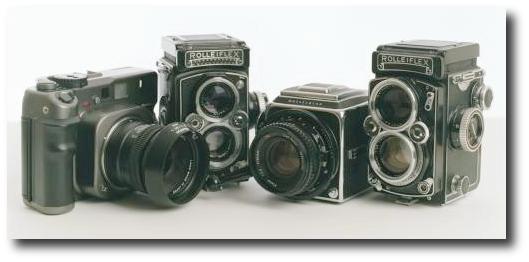
| Home |
|
Last updated: 02 June, 2004 |

Please note: I made a mistake when I enlarged the small sections of the images taken using the Rolleiflex 3.5E Model 1. The enlarger head that I use is heated specifically to encourage negative placement stabilty. However, I failed to let the negatives from this one camera completely stabilize. The new images have been installed and my conclusions have been rewritten. I'm sorry if this is a source of concern to my readers.
It must be the embarrassment of riches. I found myself wondering how vintage Rolleiflex twin lens reflex cameras compared to Hasselblads single lens reflex and Mamiyas highly touted 7-series cameras. I read where Zeiss Planar and Schneider Xenotar optics were "modern", even by todays standards. As fortune would have it, I currently possess these cameras. And I had a subject that was willing and able to help me explore a few mental musings.
Kerry Thalmann and I submit many cameras and lenses that pass through our hands to a USAF resolution test chart that was purchased from Edmond Scientific. While doing little to help me measure all important optical qualities, it's proven useful to see how a camera system resolves a scene. I have taken more than a little flak from people on the 'net who say that such charts are of little use to anyone. So one goal of this is to document findings from the field and begin to compare them with what I report in shooting a resolution test chart. What better way to know something for oneself than to perform an empiric test that compared these jewels? In the spirit of sharing information openly, I have compiled my results here. And please keep in mind that these are just four individual cameras out of literally millions that are/were manufactured. If you have cameras similar to mine, your results may/will vary.
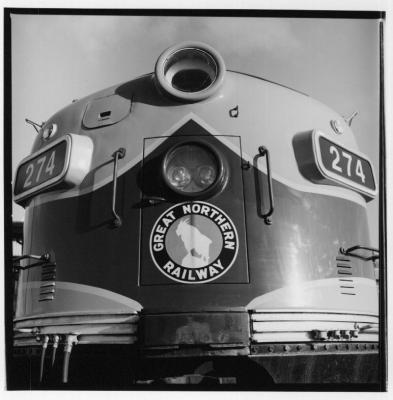
|
|
Unmanipulated Hasselblad image of the front of the F7 - 1/500th sec, f/5.6 |
First is a pair of Rolleiflex twin lens reflex cameras. It has taken me three tries before falling in love with the way Rollei TLRs work. The first two tries left me bland. But after trying a Graflex 23 and a Hasselblad, I suddenly realized what makes these cameras wonderful. Now whenever I pick one up, Rolleiflex make me smile and giggle. There's just something about old machine age gear that is well made and that is completely mechanical. Now, it seems, I can't get enough of them.
One Rollei has a serial number of 1,6xx,xxx and looks to be a 2.8E Model 1 built in 1956. It's optics are single coated Zeiss Planar. The camera is in outstanding condition. I can see only three minor cosmetic marks on it. It was recently CLA'd and operates beautifully. The other camera is a 3.5E Model 1 that was also built in 1956. Its serial number is 1,7xx,xxx and came with single coated Schneider Xenotar optics. The 3.5E Model 1 is largely unknown in Europe and several serial number lists do not include it. This camera came with distance calcualted in feet and included a meter that is activated by a switch. Overall, the camera is not in as good condition as the 2.8E. But everything surprisingly works. The cost of the 3.5E was so low as to make me blush even at the thought of it. I thought it would be interesting to compare Zeiss and Schneider optics from a similar time period.
I included a Hasselblad 500CM with 80mm CT* lens. It's multicoated optics were stunningly sharp when tested against the USAF resolution chart. This particular lens resolved 100+ lp/mm at f/8. The camera had been CLA'd with the mirror being aligned, and front/back plates corrected for alignment accuracy. It included an Accumat focusing screen. It has very bright viewing compared with the old Rolleiflex groundglass. Some people really understand and appreciate how Hasselblads work. Alas, I am not one of them. After working with Mamiya 7 and RZ gear, the Hasselblad feels old and outdated in my hands. Even the Rolleiflex feel modern, well thought out and beautifully constructed. But my thoughts on this camera are not what lead to the test, so I will move along to describing the last camera.
A Mamiya 7 represents the last camera in this test. It is the most modern camera in the group. It also has largest negative (6x7cm) and is the only camera in the test to use a rangefinder to focus. I included this camera due to the focal length of the multicoated lens (80mm) and due to it's performance when checked against a USAF resolution chart (120 lpmm). I carry this camera when I travel. It's surprisingly light and easy to use. I leave the exposure mode set on "A" (auto) and let the aperture prefered built-in meter do it's job. But for This test, I set the aperture and shutter speed based upon a Zone System reading of the scene using a Pentax one degree spot meter.
Three cameras were not included in this test. One was a mint Rolleiflex 3.5F Model 3 with a serial number 2,2xx,xxx. Another Rolleiflex missed the test too. It is a Model 1 or 2 (depending upon who's serial number list you refer to) "T". Its serial number is 2,19x,xxx and is in like new condition. Both cameras suffered from the same malady; the shutters did not trip. Though they were CLA'd, the shop that did the work hasn't figured out how to make the shutters trip reliably. They were sent to Krimar in New Jersey for a proper repair. Both cameras came back in under a week (including shipping) and work like new. I don't know what Krikor does, but it's magic. Both cameras now have Maxwell screens installed. They work beautifully. I think I should send the other two Rolleiflex in to be CLA'd as well.
The last camera that wasn't included in this test was a Mamiya RZ. I don't have a lens focal length close enough to 75mm/80mm to make the same perspective as the four test cameras. One of my goals was to make the test as easy as possible to perform. And I felt it was important to place the tripod once and simply replace the various cameras. Otherwise, I would have had to figure out a way to make the image sizes the same when transitioning from the 75mm/80mm lens cameras to a 110mm lens camera (the Mamiya RZ).
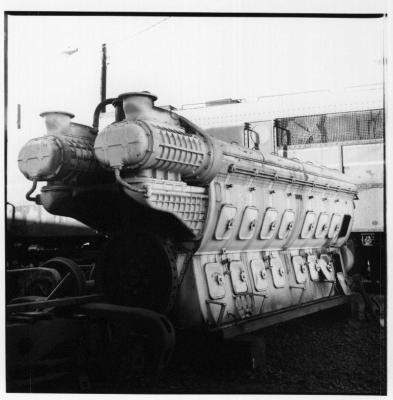
|
|
Unmanipulated Rolleiflex 2.8E image of the blown F7 motor - 1/8th sec, f/11 |
I have been taking black and white photographs for over 30 years. I have used nearly every film format that was popularly available during this time. As a result, I have formed certain ideas about cameras, film, processing, and printing. And like many humans, I hold dearly to my assumptions. Here they are, my assumptions, in no particular order:
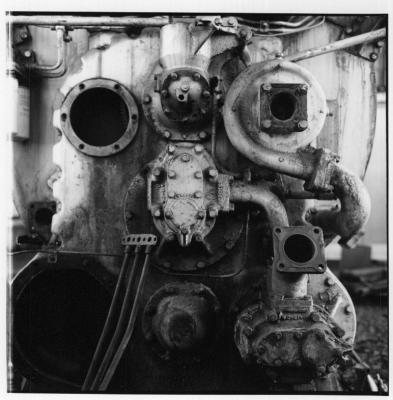
|
|
Unmanipulated Rolleiflex 3.5E image of the flywheel end of the F7 motor - 1/30th sec, f/5.6 |
LensWork recently had an editorial about finding one's subject. I enjoy taking photographs of nearly everything under the sun. But, like the editorial pointed out, some images work better than others.
After reviewing my collection of images, I am arriving at the conclusion that my better subjects are stationary, medium distance objects of complex form or shape. Metal works well for me as I tend to succeed in showing the interplay of light bouncing off the subject. To this end, I gathered up four cameras, four rolls of Kodak TMax100 film, Pentax 1 degree spot meter, a Star-D tripod, shutter release cable, and headed off to the Brooklyn Roundhouse.
The Brooklyn Roundhouse plays home to three large steam locomotives, and an ever growing collection of diesel electric engines. Doyle McCormick is well known in these parts for gathering up old and discarded engines, rebuilding them, and pressing them back into limited service. Many of his toys are found resting around the outside of the roundhouse. Included is his F7 that was painted in Great Northern livery. It's motor threw a rod sometime back. I was pleasantly suprised to find the motor with it's wretched rod resting on the ground.
Once I arrived, it took me little time to figure out that my quickest and best approach for the morning was to work the F7. The motor provided an easy subject. I needed to work quickly as the sun was creeping up over the top of the roundhouse and was going to complicate the motor photography. The engine carcass sat in bright sunshine. For the last two frames in the 6x6 cameras, there were the barn doors that enclose the working end of the roundhouse. There were plenty of subjects to choose from.

|
|
Unmanipulated Mamiya 7 image of a Great Norther Railway F7 - 1/500th sec, f/5.6 |
The processing of the negatives was very straighforward:
Similarly, the printing process was fairly straightforward:
The exposures around the motor were all 1/30 sec at f/5.6 and 1/8th sec at f/11. In all cases, I started with the wider aperture first. Then I moved to the slower shutter speed/smaller aperture combination. The side view of the Great Northern F7 were 1/500th sec at f/5.6 and 1/125th sec at f/11. The nose of the F7 were 1/250 sec at f/5.6 and 1/60th sec at f/11. The light changed while I was photographing the doors, so I removed any potential results from further consideration.
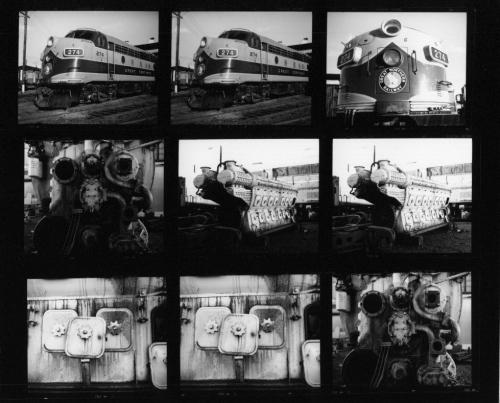 |
| Mamiya 7 80mm L contact sheet |
Beginning with the Mamiya 7, the contact sheet showed even, correctly exposed images all across the board. There was an interesting item that I found. It was that in the darkest shadowed subject, the image density changed slightly. Photographing the complex flywheel end of the motor saw a density change between 1/8th and 1/30th of a second. The 1/8th second exposure was slightly less dense. This effect was seen in all the contact sheets from the four cameras I tested.
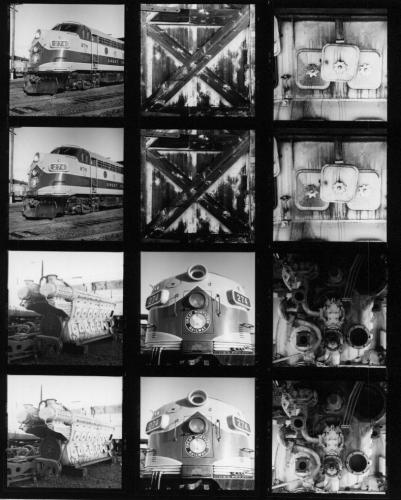 |
| Rolleiflex 3.5E Model 1 75mm Xenotar contact sheet |
The Rolleiflex 3.5E contact sheet shows that the shutter is slightly slow when comparing the exposures with the other three cameras. There was no apparent flare around the edges of the frames where the scene contrast was extreme (see the photos of the end of the motor that were shot into bright sunlight). After looking at the contact sheet I was excited to see how the enlargements would compare.
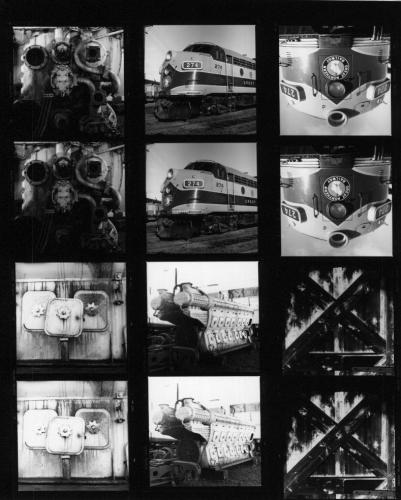 |
| Hasselblad 80mm CT* Planar contact sheet |
The Hasselblad 500CM contact sheet shows a very even exposure across the entire range of images. As with the other cameras, there is a slight density difference between the 1/8th second and the 1/30th second exposures. 1/30th second is slightly more dense than the longer timed images. With TMax100 film I wasn't expecting to see any reciprosity failure on this short an exposure. So I am at a loss to explain the differences that I see.
Note: In all cases, the Hasselblads mirror was locked in the up position prior to triggering the shutter. I did this to ensure the absolute best resolution would be achieved when using this camera.
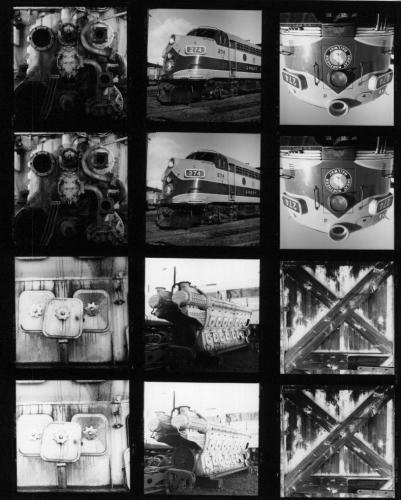 |
| Rolleiflex 2.8E Model 1 80mm Planar contact sheet |
The Rolleiflex 2.8E contact sheet shows a very even exposure across the range of images. I expected this as the shutter was recently CLA'd. There was a small amount of flare around the edges of the frames where the scene contrast was extreme (see the photos of the end of the motor that were shot into bright sunlight). It appears that this early E model would experience image bleeding around the edges of the frame under the right conditions.
In summary, a review of the contact sheets showed only minor differences. The slightly slower shutter of the Rolleiflex 3.5E being the most obvious difference. The Rolleiflex 2.8E frame bleeding when pointed into bright sun was the other obvious difference. Otherwise, all contact sheets were clean, clear, and proved that making enlargements would be straightforward.
After making proof sheets from the four rolls of film, I chose a one image to print identical copies of. The image was choosen for it's contrast range and exposure. The contrast range of the scene with the motor resting on the ground was very long. The shadows were placed in Zone 2 and the sky fell around Zone 10. The exposure was 1/8th sec at f/11. I was hoping that this would be around the sharpest aperture for the four cameras. All prints were made to 7.5 x 7.5 inches.
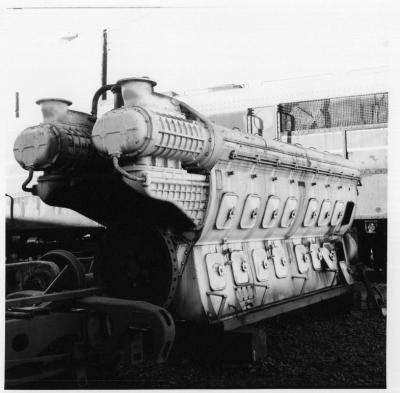 |
|
F7 motor, Mamiya 7 1/8th sec, f/11 |
Starting with the Mamiya 7, the print of the motor is very sharp, shows outstanding contrast, handled the transitions from dark to light very well, and in general returned a very clean print. There is the appropriate Zone3 details in the shadows, particularly under the flywheel on the front of the motor. The light pole that sat in the bright sun shine is nicely detailed. And the underside of the lamp as well as the glass dome that hangs from it are just visible. These items were placed up around Zone8 or 9.
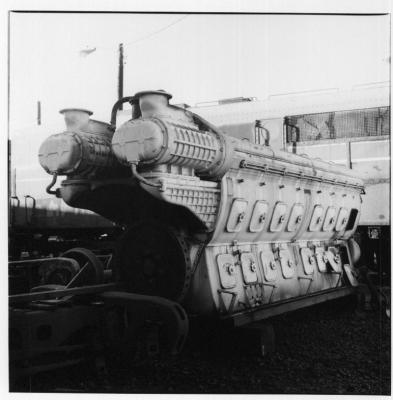 |
|
F7 motor, Rolleiflex 3.5E 1/8th sec, f/11 |
The Rolleiflex 3.5E print, when compared with the Mamiya 7 image, is less contrasty. The shadows are softer and more "luminous". The highlights (areas exposed around Zone7 or 8) show nice detail. The light pole, lamp, and glass dome that sat in the sun light match the density and clarity of the Mamiya 7. But because of the way the optics handle scene luminance, the print appears at first glance to be not as sharp as the Mamiya print. The image is still pleasing and I doubt that anyone would complain if they didn't have the other prints to compare it with. But it is obvious that it handles contrast differently than the Mamiya.
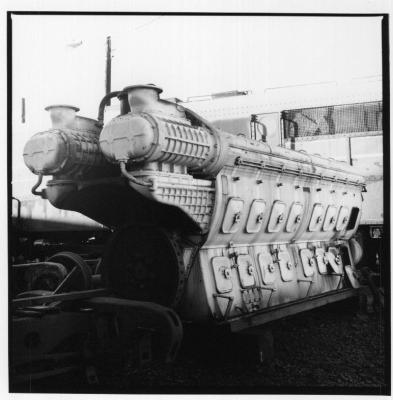 |
|
F7 motor, Hasselblad 1/8th sec, f/11 |
The Hasselblad 500CM print shows slight differences from the Mamiya print. Print resolution is indistinguishable from the Mamiya print. That is to say, it's outstanding and is pleasing to look at. One difference is in the way the shadow areas are rendered. The Hasselblad print gave clear, nicely illuminated Zone3 details. But the overall shadow rendition is less contrasty than the Mamiya Zone3 areas. Another difference is in the amount of flare that spills from the Zone 15+ areas of the image (look on the lefthand edge of the print at the areas leading into the flywheel). Where the Mamiya returned absolutely no flare or bleeding from the Zone15+, the Hasselblads Zeiss Planar increased the Zone3 density to around Zone4. Here too, if a person had no other print to compare against, the Hasselblad print would be quite nice.
 |
|
F7 motor, Rolleiflex 2.8E 1/8th sec, f/11 |
The Rolleiflex 2.8E print is very sharp and treats the overall scene well. The Zone3 areas under the motors flywheel match the densities of the Hasselblad and Rolleiflex 3.5E prints. That is to say, its lighting effect is softer than the contrasty Mamiya 7 print. There is also a very slight bleed effect from the Zone15+ areas into the Zone3 region. But the effect is less than the Hasselblad image. The overall apparent sharpness matches the Mamiya and Hasselblad prints.
In summary, a review of the first prints shows that only the Rolleiflex 3.5E is distinguishable, in an overall manner, from the Rolleiflex 2.8E, Mamiya 7, and Hasselblad 500CM prints. The Rolleiflex 2.8E print gave pleasing Zone3 rendition and showed a very slight Zone15+ bleed into Zone3 areas. The Hasselblad 500CM print Zone3 rendition matched the Rolleiflex 2.8E. But the Hasselblad also returned slight, but noticable Zone15+ bleeding into the Zone3 region. Lastly, the Mamiya 7 print show wonderul contrast in the Zone3 region and returned no detectable Zone15+ bleeding into the Zone3 areas. All differences are noticable only upon close examination of the prints side by side.
After printing an entire scene, I raised the enlarger head to its maximum height and selected representative details from two scenes. I also selected one scene that used f/5.6 and another that was shot at f/11. I wanted to see what effect, if any, the aperture setting had in very large prints. The effective enlargement size was 25 x 25 inches.
The first set of images comes from the front of the Great Northern F7. A full view of the photo used or this part of the test is found in the section titled The Contestants. The handle is found just under and to the left of the center light housing. The screw found in the upper left hand corner of the frame is the object what I compared the four print results against.
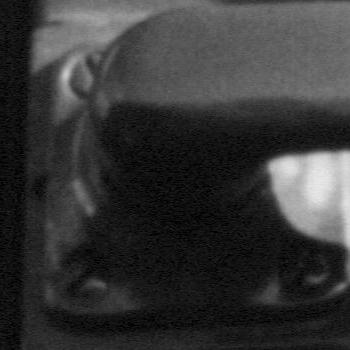 |
|
F7, Mamiya 7 1/500th sec, f/5.6 |
Starting with the Mamiya 7, I see that the film grain is just now becoming visible. In fact, if there's one thing I should comment on, it's the tightness of Kodak TMax100's grain structure. It has held up very well under high magnification.
The screw that I am using to compare the various cameras appears sharp and contrasty in the Mamiya 7 print. I can see it has form and shape.
I hadn't intended on enlarging the subject seen behind the lamp glass on the headlight. But in the Mamiya 7 print there is a gasket that appears sharp, contrasty, and subtly formed.
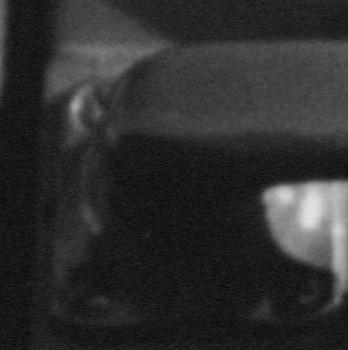 |
|
F7, Rolleiflex 3.5E 1/500th sec, f/5.6 |
The Rolleiflex 3.5E print, when compared with the Mamiya 7 image, shows slightly less contrst, and slighly less resolution of the screw. If I didn't have the Mamiya 7 print to compare it to, I would have said that the print was nice, sharp, and world work very well as a 25 x 25 inch enlargement.
The gasket that is not shown is well formed, but not quite as sharp as in the Mamiya 7 image.
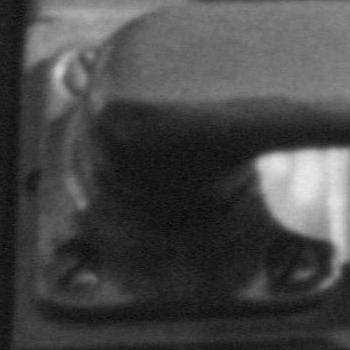 |
|
F7, Hasselblad 1/500th sec, f/5.6 |
The Hasselblad 500CM print shows slight differences from the Mamiya 7 print. The screw is sharp, but less contrasty than in the Mamiya image. The gasket behind the headlight glass is nearly as sharp, but not quite as contrasty as the comparison print. Overall, the Hasselblad image is slightly, but visibly, less sharp than the Rolleiflex 2.8E image discussed in the following paragraph.
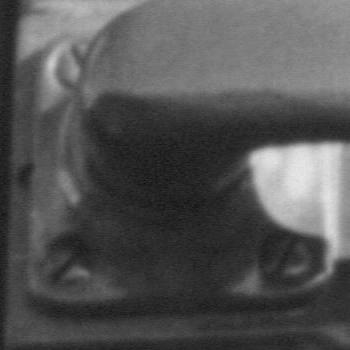 |
|
F7, Rolleiflex 2.8E 1/500th sec, f/5.6 |
The Rolleiflex 2.8E print, when compared with the Hasselblad image, shows similar contrast and better resolution of the screw. The Rollei print shows nearly as fine definition of the screw as the Mamiya print does. However, when comparing the gasket area, the Rollei's image is slightly worse than the Hasselblad. I have no idea why this would be the case. But I wonder if the film lays perfectly flat across the film plane in these old Rolleiflex. What I am describing is very subtle and may be difficult for some people to see.
The second group of closeups come from the F7 motor that was resting on the ground. The full image that was used for this part of the test is found in the section titled The Prints - Small. The bolt is found in the upper part of the frame on the front of the motor around the area where the face plate curves under the ends of the crankshaft.
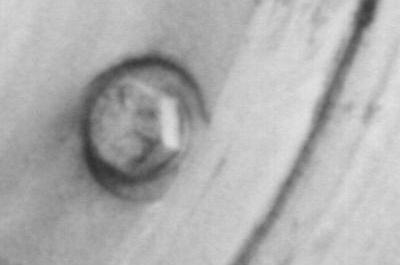 |
|
F7 motor, Mamiya 7 1/8th sec, f/11 |
Starting with the Mamiya 7, the print of the bolt is very sharp, contrasty, and the entire print shows an amazing amount of detail throughout the scene. By this time it's becoming nearly redundant to say these things about the Mamiya 7 prints. But in this test, the results are beginning to speak for themselves.
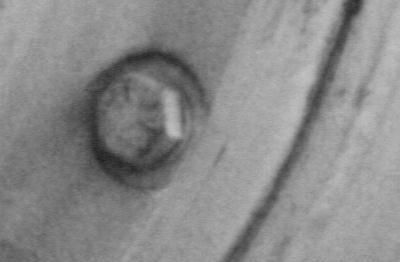 |
|
F7 motor, Rolleiflex 3.5E 1/8th sec, f/11 |
The Rolleiflex 3.5E print, when compared with the Mamiya 7 image, is nearly as sharp and contrasty. The bolt is still very well formed. It appears to match the quality of the Rolleiflex 2.8E print. Simply stunning. At this enlargement size the grain of Kodak TMax100 film is just becoming visible to the naked eye.
 |
|
F7 motor, Hasselblad 1/8th sec, f/11 |
The Hasselblad 500CM print shows differences from the Mamiya image. The bolt in question appear sharp and contrasty. But it's not quite as sharp and contrasty as in the Mamiya print. By this point, I am beginning to wonder if the rumours of Zeiss contrast are true or only based on deep and dark arcane folklore.
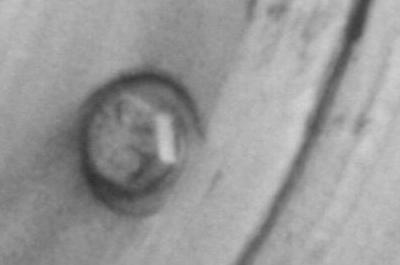 |
|
F7 motor, Rolleiflex 2.8E 1/8th sec, f/11 |
The Rolleiflex 2.8E print is very sharp and treats the overall scene with nearly as fine rendition as the Mamiya 7. In fact, the bolt in question is sharper than in the Hasselblad print, and just slightly less sharp when compared with the Mamiya image.
Whatever I said in about optics in the Assumptions section regarding my thoughts about how well Zeiss and Schneider could have constructed lenses ing the 1950's need to be taken back now. The 2.8E print is so fine at f/11 that it's nearly indistinguishable from the Mamiya enlargement. That it beats the Hasselblad print is simply over the top amazing. I'm so surprised that I'm going to go back and recheck my already rechecked findings in the original negatives. Whew!
In conclusion, the enlargements made to 25 x 25 inches show subtle and sometimes difficult to tease out differences between the four camera systems. The Mamiya 7 prints have been consistantly sharp and contrasty. Both the Rolleiflex 2.8E and 3.5E are amazing in their ability to sometime better the prints taken by the Hasselblad 500CM. I'm really wielding Ocam's Razor in passing these judgements.
To confirm my results from the field, I turned to tests that I have performed over the years using a USAF Resolution Test chart. The chart came from Edmond Scientific and is fairly cheap at less than $20US. I use Kodak TMax100 film souped in D76. I then raise my enlarger to it's top, use the 80mm Nikkor enlarging lens, and view the negatives through an Omega grain focuser. At this enlargement, I can clearly see the very small TMax100 grain and can view all the way down to the smallest potentially resolved test chart bar group. The film limit of resolution barely exceeds 135 lines per mm in my environment.
The following is a side by side resolution comparison between the four cameras in this test. Resolution is reported in lines per mm. From left to right, I show the center, middle, and edge resolution readings at the specified apertures.
|
Mamiya 7 80mm L |
Rolleiflex 2.8E 80mm Planar |
Rolleiflex 3.5E 75mm Xenotar |
Hasselblad 500CM 80mm CT* Planar |
|
120 120 60 f/4 120 120 68 f5.6 120 107 68 f/8 107 107 76 f/11 76 76 68 f/16 60 60 60 f/22 |
68 68 42 f/2.8
76 96 68 f/4 68 76 68 f/5.6 96 96 76 f/8 96 85 68 f/11 68 76 60 f/16 54 60 48 f/22 |
48 48 24 f/3.5 85 96 42 f/5.6 96 96 68 f/8 76 85 60 f/11 68 68 54 f/16 54 54 42 f/22 |
68 68 38 f/2.8
60 60 34 f/4 96 96 54 f/5.6 96 107 60 f/8 85 76 60 f/11 68 68 60 f/16 54 48 48 f/22 |
From these results it can be seen that the Mamiya 7 80mm L camera system is simply the finest, most accurately focused camera of the four I tested. The Rolleiflex and Hasselblad cameras all resolve very similarly. There is, for all practical purposes, no difference in their ability to resolve a scene. All appear to have very fine optics.
One thing that I have noticed over the years is that some 120 format camera systems keep the film flat better than others. I believe it is film flatness control in the Mamiya that helped it acheive such incredible resolution figures. The other three cameras film appears to bow and buckle very slightly as it travels across the film plate. It may be that the Rolleiflex and Hasselblad systems are capable of the higher on-film resolution results. For this test, though, the cameras seemed to do well to approach 100 lines per mm resolution.
This test proved to me several things. First, c.1956 Rolleiflex Twin Lens Reflex cameras can keep up with modern photographic equipment. Let me put this another way; I'm blown away by the fact that a 50 year old single coated lens camera can produce large prints that show as much fine resolution and detail as the best modern multicoated lens that I currently own. Both Rolleiflex tested at 96 lines per mm against the USAF Resolution test chart. This equals the newer Zeiss Planar optics in the Hasselblad. Both Rolleiflex controlled flare better than the 500CM too. In practical use, a photographer would be very hard pressed to tell the difference between images taken with c.1956 Rolleiflex and the latest greatest mulitcoated wonder-camera. In oh so many ways, this was a staggering realization.
I believe that my assumptions regarding the USAF resolution testing that my friends and I have performed over the years is valid. All cameras produced incredible images with very clear definition and high resolution. We can see that the USAF test results mirror nicely the results from the field. Every camera is sharp in the field.
Some of my original assumptions need to be reassessed. I originally thought
that the Zeiss multicoated optics would be the most contastly in the field.
However, the Mamiya 7 produced
consistantly better contrast images than the Hasselblad. Furthermore,
the Mamiya controlled flare better than the 500CM.
I'm happy to know with certainty just how good the Mamiya 7 is.
It has best in class resolution and acheives this in concert with best
in class contrast. Fraction Calculator
The Hasselblad was the only SLR in this test (for reasons previously given). I think the Hasselblad is a fine camera with outstanding optics. That a 50 year old camera can keep up with it does nothing to diminish the value or usefulness of the 500CM camera system. If there was a surprise for me in testing the Hasselblad, it was in the way it did not control flare quite as outstandingly as the c.1956 Rolleiflex TLRs or the newer Mamiya 7. For this statement to be true, I needed to stress the camera in a 12+ Zone exposure range (Zone3 to Zone15+). Such conditions are seldom experienced in a way that what the Hasselblad returned would be seen as unpleasing or unacceptable. The 500CM with it's 80mm CT* Planar lens remains an outstanding achievement for Hasselblad.
My tried and true Mamiya 7 travel companion came shining through.
I had assumed its optics were slightly less contrasty than the
Hasselblads 80mm CT* Planar. With the possible exception of its
interchangable film backs, I no longer feel that I'm missing
something now that I sold the beautiful 500CM.
While Mamiya has made consistantly fine camera equipment,
I somehow believed that the Hasselblad was a sharper, more
constrasty solution. In this test, the Mamiya 7 is the hands
down winner on all accounts. On this day, there was none better.
But there were these two little 50 year old cameras that gave the
young pups on the block a good run for their money. I knew
there was a reason I needed to give Rolleiflex twin lens reflex a
third try. I'm glad I did.
Divisible Information